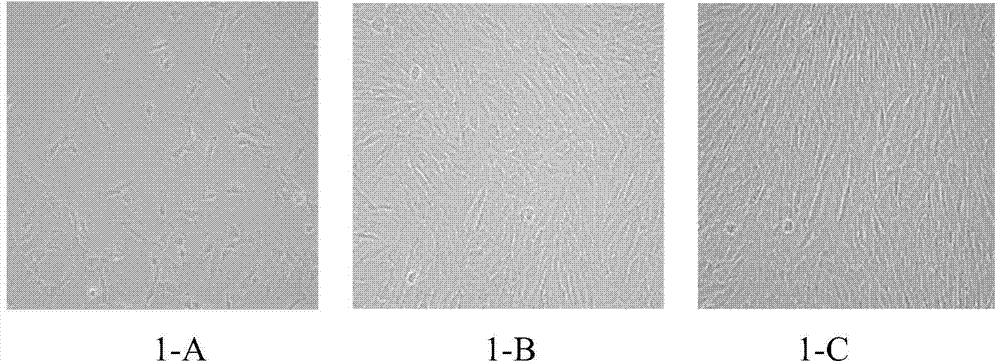Composite stent material
A technology of composite scaffolds and composites, applied in medical science, prostheses, etc., can solve the problems of low content, narrow application range of bone marrow mesenchymal stem cells, and limited source of stem cells
- Summary
- Abstract
- Description
- Claims
- Application Information
AI Technical Summary
Problems solved by technology
Method used
Image
Examples
Embodiment 1
[0050] Example 1 The acquisition of dental pulp stem cells
[0051] With the consent of the family members, clinically collected deciduous teeth extracted from children due to detention, and no dental pulp disease and necrosis were required. Immediately after pulling out, put it in a PBS centrifuge tube containing double antibody when it is cold at 4°C, and take it out for use within 24 hours. The teeth were taken out, rinsed three times repeatedly with PBS solution containing double antibodies, wrapped in sterile gauze and cracked with forceps; the pulp tissue was clamped with sterile tweezers, and 1mm of the pulp tissue at the apex was excised; Curved scissors cut the pulp tissue into 1mm 3 , put in a 50mL centrifuge tube, add 10 times the volume of 5g / L type I collagenase, seal the seal and mix well, transfer to a constant temperature air shaker, digest at 37°C and 200R for 10-20min; add an equal volume of serum-free culture Repeatedly blow and beat the discrete cell aggr...
Embodiment 2
[0053] Example 2 Acquisition of bone marrow stem cells
[0054] With the consent of the family members and the person, the doctor uses a bone marrow puncture trocar to aspirate 5-8 mL of bone marrow, put it in an anticoagulant tube containing serum-free medium, rotate it gently and mix well, and then take it back to the laboratory for processing; In the ultra-clean workbench, transfer the uncoagulated bone marrow into a centrifuge tube, add the same volume of serum-free medium, centrifuge at 1000rpm for 20min; discard the supernatant and tissue fluid, resuspend in 2mL of serum-free medium, and transfer it into a new sterile tube. Mix well in a centrifuge tube, centrifuge at 1000rpm for 10min; discard the supernatant, add 15% FBS DMEM / F12 medium equal to the volume of the precipitate to resuspend, dilute 30-50 times, inoculate in a petri dish for culture, and store at 37°C and humidity Cultivate in a 95% carbon dioxide incubator; change the medium every day for the first three ...
Embodiment 3
[0056] Example 3 In vitro osteogenesis induction experiment
[0057] The dental pulp mesenchymal stem cells obtained in Example 1 and the bone marrow mesenchymal stem cells obtained in Example 2 that grew well and approached confluence in the P3 generation were respectively taken, digested with trypsin, and made a cell suspension with a new medium, and then counted. Adjust the cell density to 1 x 10 5 / mL, according to 1×10 4 cell / cm 2 Seed into 6-well plate, 2mL / well. When the cells grew to 80% confluence, the culture medium was discarded and replaced with osteogenic induction medium, 2 mL / well (the control group was cells, and ordinary medium was used instead of induction factor medium). Continuous induction, the induction medium was replaced every 3 days, and the induction was stopped on the 28th day, and the cell changes were detected by Alizarin red staining and the dentin matrix protein 1 (DMP1) and sclerostin (SOST) were detected by Real-time fluorescent quantitative...
PUM
 Login to View More
Login to View More Abstract
Description
Claims
Application Information
 Login to View More
Login to View More - R&D
- Intellectual Property
- Life Sciences
- Materials
- Tech Scout
- Unparalleled Data Quality
- Higher Quality Content
- 60% Fewer Hallucinations
Browse by: Latest US Patents, China's latest patents, Technical Efficacy Thesaurus, Application Domain, Technology Topic, Popular Technical Reports.
© 2025 PatSnap. All rights reserved.Legal|Privacy policy|Modern Slavery Act Transparency Statement|Sitemap|About US| Contact US: help@patsnap.com



